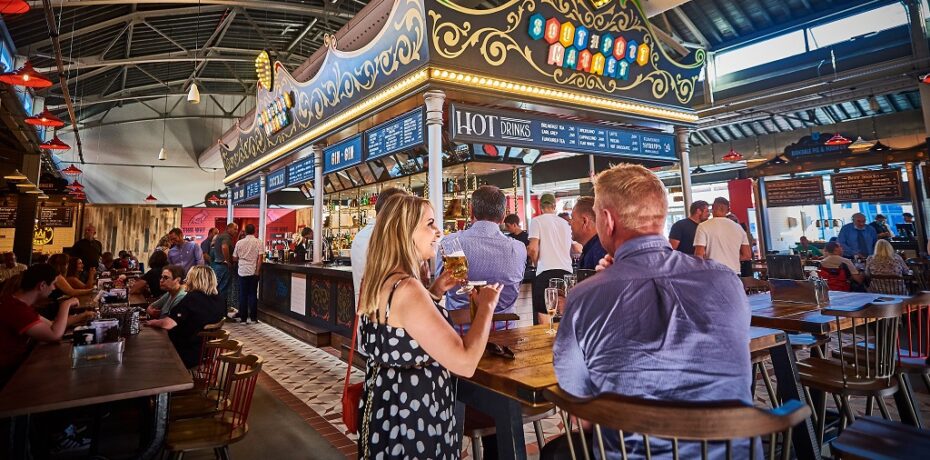The Subplot
The Subplot | Flex space tango, staycation nation, numbers to ponder
Welcome to The Subplot, your regular slice of commentary on the North West business and property market from Place North West.
THIS WEEK
- Eat, drink and be merry: North West hospitality is back in business
- Staycation nation: Occupancy is up, room rates are up, tails are up
- WeWork meets Cushwake: Property consultants pick their coworking partners

HERE TODAY, GONE TOMORROW
 Staycation expectation
Staycation expectation
October will see the opening of Select Property Group’s second Manchester aparthotel, CitySuites Two, at Embankment West.
The 142-apartment block enters a local hospitality market that is full of long-term confidence and short-term confusion.
Subplot takes the hospitality sector’s high season temperature.
The staycation summer has been kinder to the operators of self-contained accommodation than to hoteliers thanks to lower overheads, weekly rather than daily service routines, and greater flexibility. Airbnb’s 3,200 Manchester beds are reported to be recording occupancy at a little short of 70%, with day rates resilient throughout the pandemic and now climbing by about 15% from the low point to peak at £110. CitySuites says its occupancy is up in the mid-70% region, not quite the high-80% of summer 2019 but more than enough to keep the show on the road. Doing rather less well, the Manchester Hoteliers Association reports occupancy of 60% in July, sharply up from the 40% in May but still lagging.
Resilient
CitySuites thinks it scored a march on its rivals by using the lockdowns to rethink its booking platform, loyalty and referral schemes and to repaint every apartment. Savills data shows that aparthotels have generally been more resilient, pandemic or not. Average occupancy was always a shade above hotels as far back as the turn of 2019/20.
Minority interest
Yet despite six years of relentless talking-up by the property sector, aparthotels remain a relative novelty: just 9.6% of the beds in the top 10 European hotel cities were in aparthotels in 2019, and the proportion in the North West was almost certainly much lower. Thanks to lower occupancy in aparthotels, the number of bednights (think about it) was just 7.9%, barely higher than the 7.3% scored by Airbnb.
Targets
Manchester-based CitySuites operations director Gavin Bailey is reluctant to endorse the idea his business is fighting for bookings with Airbnb. “I understand the comparison,” he says. “But our comparator is really the big luxury hotels. We’re not offering just standard serviced apartments.” Bailey thinks there is still room for another CitySuites outlet in Manchester (although he’d want to try a different part of the city), and hopes to ink two new deals elsewhere in England by the end of the year. The UK’s Top 10 Cities will be his targets.
The camera never lies
CitySuites also has its eye on Liverpool (Select already has experience there in the student sector). The city’s leisure economy is back off the canvas, with the after-dark leisure offer performing particularly well. Centre for Cities data released last week (Subplot, 17 August) is now confirmed by numbers based on CCTV tracking from Liverpool BID.
Mersey flows
Total footfall in the week 19-25 July nudged up from 1.29m to 1.34m, heading back to the 1.4m recorded before the pandemic. Perhaps more significantly, the figures showed a mighty surge in late night pedestrian flows: up 27% from 9pm to midnight, compared to pre-pandemic levels, and up a staggering 66% in the midnight to 7am slot. There are still hills to climb. While Friday and Saturday nights are buzzing, Sundays remain below pre-pandemic levels. Weekend hotel visits are clearly not fully back yet.
Lovely lakes
The best news comes from the region’s staycation magnet: the Lake District. “We’re seeing 90% occupancy, well ahead of normal, and room rents up too. I’m meeting a lot of happy hotel owners,” says Julian Troup, Colliers UK head of hotels. The big debate among hoteliers is by how much to bump their room rates. “Some are charging a fortune, others holding the price rise to 10-20% in the hope that visitors will come back next year,” Troup says.
Trip hazards
There are some bigger issues looming: the medium-term pipeline of newly developed North West hotel rooms is going to cause problems. Over-supply is a real, if temporary, concern as Subplot reported this spring (27 April).
Pay them more
But recruitment is the big worry: everyone Subplot spoke to pointed to this as the hospitality sector’s constant concern. In the medium-term a demographic bulge will deliver a surge in the number of 18-year-olds. This holds out some hope of replacing European Union citizens who have departed. But in a market economy, paying more money is the obvious (and only) answer. So don’t expect room rates to dip anytime soon.
DRIVING THE WEEK
Eat, drink and be merry
Over five million people have visited Southport already this year, 16.5% up on 2020, and 5.1% higher than pre-pandemic 2019. There’s also good news for other North West towns. But Oxford Economics warns the big picture is more challenging.
Were you one of the 5,065,024 people to visit Southport so far this year? The not-quite-seaside town is pulling in the punters against a regional trend which has seen football plunge and stay low (see Subplot, 17 August). The town’s cheerleaders say a new 38,000 sq ft Beales department store and a £1.4m makeover of the market foodhall (pictured) have helped. The data from Springboard Research reinforces the message from the Centre for Cities that towns in general (and resorts in particular) are recovering fast. The weekend and leisure economies in Burnley, Blackburn, Wigan, Warrington and Birkenhead are also turning in strong and improving performances. Local is the new normal, it seems.
Return of the old normal
Economic performance this year, and maybe next, will be patchy and hard to read: normal is exactly what they will not be. However, Oxford Economics’ latest regional trends research suggests the medium-term picture is a rampant return to the predictable. The North West comes out looking dangerously average. London’s pandemic eclipse will be short and temporary, and it will roar ahead.
Hot air
The big takeaway is that in the years to 2025, London will reassert its dominance to such an extent that Boris Johnson’s hazy “Levelling Up” agenda amounts to nothing much. “Although the UK government plans to publish a White Paper on levelling up later this year, we are not expecting that to lead us to revise our medium-term forecasts—especially against the context of tight public spending plans and the decision to leave the European Union,” Oxford Economics observes.
Regional spread
That is because although the gap between regional growth and London growth is narrower than it was, it is still widening. London is predicted to grow its GVA by 1.7% annually 2020-25, and the North West by 1.2%, an unusually small gap. But compounding 0.5% growth each year quickly adds up to an ever-more yawning wealth gap. Only the anaemic West Midlands economy and the perma-troubled North East are expected to do worse than the North West.
Bottom of the class
Comparing projected performance with a 2019 baseline, the North West comes out looking even worse: second to the bottom. Only the West Midlands making more of a mess of its recovery. “Over the period to 2025 and beyond, economic fundamentals will re-emerge. London’s advantages mean that it is likely to lead GVA growth,” Oxford Economics notes.
Winners and losers
Region-wide projections conceal huge local variations. Wealthy and flourishing parts of the North West can expect to continue to flourish. Meanwhile failure to deal with the big issues holding the North West back will be disguised by rising real disposable household income, which will grow at an annual rate of 1.6% in the North West. By national standards, that is relatively good, albeit from a lowish base (London comes in at 1.9%). Manchester will probably be OK, in part because of a well-educated labour force where 45.6% of the 25-64 age group is educated to degree level. The future is less rosy for Birmingham with only 38.6% holding degrees. The West Midlands is likely to be the slowest performer well into the second half of the decade, said Oxford Economics.
Conclusion: There’s a long rocky road ahead for the North West, but it’s rockier in the Midlands.
IN CASE YOU MISSED IT…
 Take your partners, please, for the serviced office foxtrot
Take your partners, please, for the serviced office foxtrot
Cushman & Wakefield has signed a new arrangement with WeWork, while the other big brokers are choosing flex space dance partners. What happens when the music stops?
In the baffling language of corporate media relations WeWork and Cushman & Wakefield have agreed an “exclusive strategic partnership to deliver an innovative flexible space operating platform.”
First attempt
This seems to mean that landlords with some flex space to spare can, via Cushwake, sell on WeWork’s platform. Or perhaps on what the press statement calls some “new jointly developed solutions.” WeWork contributes the shop window and hospitality, Cushwake the asset and facilities management and, bingo, you have “a differentiated workplace experience for tenants and employees in the new hybrid world of work where flexibility remains at the forefront.” Separately but not separately (the language of corporate media relations is wonderfully smudged), Cushwake stumps up $150m.
Put that another way
What that amounts to is that Cushwake has joined the long list of big name surveyors and brokerages offering their own flexible workspace solution. They follow Knight Frank which partnered with Work.Life, CBRE produced Hana, later taken over by flex operator Industrious, and so on. In the process Cushwake scribbles all over the dance cards of Colliers, JLL and CBRE who already have relationships with WeWork (Colliers in Manchester and Birmingham, JLL and CBRE in London, CBRE in Dublin). Nobody seems very clear what the new relationship means, and that includes UK sources in Cushwake and WeWork. The scope for trouble has to be high.
And yet another way
Time will tell if the proliferating partnerships between brokers and flex operators deliver, or even endure. Is this vertical integration, horizontal integration, or just panic? Probably panic. For now its just another side of the flex workspace sector’s rapid and often unsettling post-pandemic growth. “Global occupiers are now taking flex space in the regions, which is a very rapid change and for operators, it was unexpected, and it isn’t always a good thing if it leaves flex operators more vulnerable to single large clients,” explains Patrick Kennedy, flex space guru at Colliers in Manchester. Colliers, he says, don’t plan to tie up with anyone.
For now the music is playing and everyone is whirling round the flex space dance floor. When the music stops, who will be with whom?
The Subplot is brought to you in association with Cratus and Oppidan Life.





